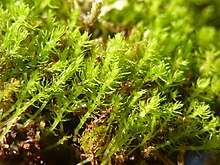Takakia lepidozioides
Appearance
| Takakia lepidozioides | |
|---|---|

| |
| Takakia lepidoziodes on a damp slope above Takakia Lake, Haida Gwaii | |
| Scientific classification | |
| Kingdom: | Plantae |
| Division: | Bryophyta |
| Subdivision: | Takakiophytina |
| Class: | Takakiopsida |
| Order: | Takakiales |
| Family: | Takakiaceae |
| Genus: | Takakia |
| Species: | T. lepidozioides
|
| Binomial name | |
| Takakia lepidozioides | |
Takakia lepidozioides is a species of moss in the Takakiaceae family, one of two species of Takakia. It is characterized by its tiny bifid leaves in which each segment is only a few cells wide, conspicuous rhizomous shoots, and long leafless stolon shoots which facilitate the colonization of bare areas. A very unusual feature is the lack of male plants within the species, which are thought to have become extinct during an ice age. Takakia lepidozioides have been found to be a highly adaptive moss. Over the past 65 million years, there have been extreme changes in the climate, however, several molecular adaptations have been observed in this species. [2]
References
[edit]- ^ Hattori, S.; Inoue, H. (1958). "Preliminary report on Takakia lepidozioides". Journal of the Hattori Botanical Laboratory. 19: 133–137.
- ^ Hu, R., Li, X., Hu, Y., Zhang, R., Lv, Q., Zhang, M., Sheng, X., Zhao, F., Chen, Z., Ding, Y., Yuan, H., Wu, X., Xing, S., Yan, X., Bao, F., Wan, P., Xiao, L., Wang, X., Xiao, W., … He, Y. (2023). Adaptive evolution of the enigmatic Takakia now facing climate change in Tibet. Cell, 186(17), 3558-3576.e17. https://doi.org/10.1016/j.cell.2023.07.003
External links
[edit]
